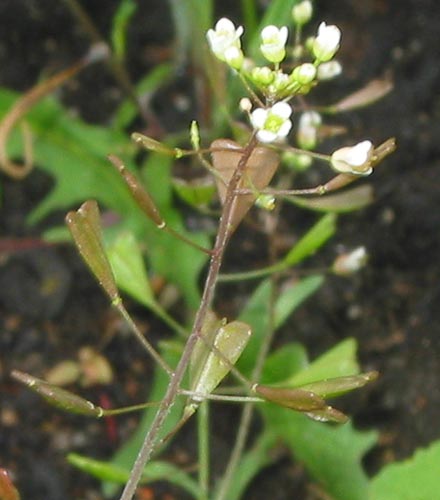Weeds
Capsella bursa-pastoris (L.) Medik. - Shepherd's purse.
Taxonomy.
Family Brassicaceae Burnett (Cruciferae Juss.), Genus Capsella Medik.Biology type.
Spring annual, also develops as winter annual.Morphology and biology.
Polymorphic species. Stem is 20-60 cm high, simple or branched. Root is spindle-shaped. Lower leaves, whole to pinnatipartite, are in rosette. Few cauline leaves, oblong or lanceolate, are sessile. Upper leaves are near-linear, with arrow-shaped base. Inflorescence is loose raceme with tetramerous actinomorphic flowers, petals are white. Fruit is inversely-triangular, heart-shaped silicle with narrow cross wall. Productivity is up to 70000 seeds per plant. Optimum temperature of seed germination is 15-26°C, minimum - 1-2°C, maximum - 32-34°C. Seedlings appear from March to May, and again in August-September. Summer and autumn plants over winter. Wintering forms flower from March to May, spring forms, in June-July. Bearing is from June to September. Newly ripe seeds have low germinability. Seeds germinate from a depth of no more than 2-3 cm. Seed viability is no more than 11 years.Geographical range.
Cosmopolitan. This weed is found in all parts of the world except tropical regions. It has spread across the entire region of the Former Soviet Union up to the northern limits of agriculture.Ecology.
C. bursa-pastoris grows on all types of soils, preferring loose ones. Anthropochore, autochore. In taiga zone, especially in northern part, it is one of the most pernicious agricultural weeds, especially in winter cereals. In more southern regions it is mainly a ruderal plant.Economic value.
Segetal weed in spring and winter cereals, tilled crops, fodder grasses, fallows, vegetable and fruit gardens. As a ruderal plant, it grows on wastelands, rubbish dumps and along roads. Control measures: Shallow plowing 6-8 cm in depth is recommended just after harvest. Autumn plowing is recommended after the germination of weed seeds. In spring cultivation is used to control the rosettes of wintered plants. In row crops inter-row tillage is recommended.Reference citations:
Agaev M.G., ed. 1988. Main agricultural weeds in crops of Leningrad region. Catalogue of VIR world collection. Issue 468. Leningrad. 40-42 pp.Bush, N.A. & V.L. Komarov, ed. 1939. Flora of USSR. Moscow-Leningrad. V.8: 603-604.
Nikitin V.V. 1983. Weeds in the flora of USSR. Leningrad: Nauka. 220 pp.
Shlyakova E.V. 1982. Identification book on agricultural weeds in Non-Chernozem zone. Leningrad: Kolos. 82 pp.
Ulyanova T.N. 1998. Weeds in the flora of Russia and other FSU states. Saint Petersburg: VIR. 229, 232 pp.
Zotova A.P. 1971. Weed plants and their control. Leningrad: Lenizdat. 78, 80 pp.


